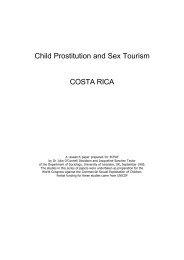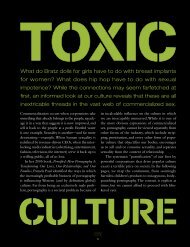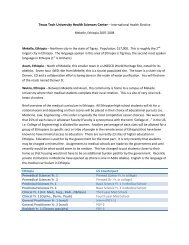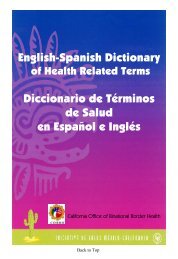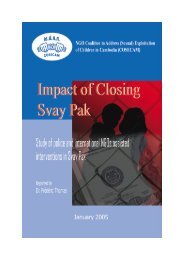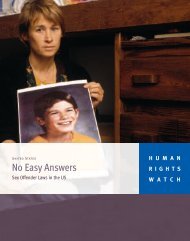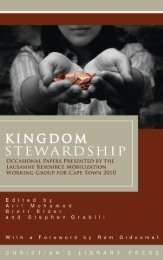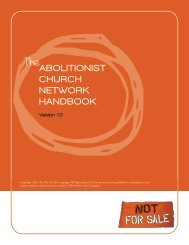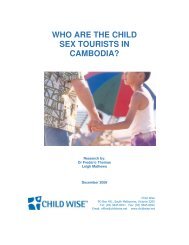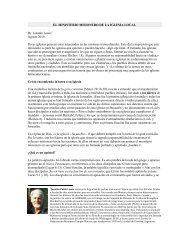COSECAM - World Wide Open
COSECAM - World Wide Open
COSECAM - World Wide Open
You also want an ePaper? Increase the reach of your titles
YUMPU automatically turns print PDFs into web optimized ePapers that Google loves.
CHILD SEX DEMAND FACTORS, A RESEARCH IN CAMBODIA<br />
STUDY MODULE 1<br />
!"#$%#&'(%)*&)'(+!,%<br />
!RAFFIC'() CA+,O)IAN GIRLS<br />
SP(A' OU!%%<br />
Child Participation in Planning Project<br />
NGO COALITION TO ADDRESS SEXUAL<br />
EXPLOITATION OF CHILDREN IN CAMBODIA<br />
(<strong>COSECAM</strong>)<br />
Reported<br />
by<br />
Sandy Hudd<br />
May 2003<br />
Project funded by<br />
the United Nations Inter-Agency Project on Trafficking of<br />
Women and Children in the Mekong Sub-Region
TABLE OF CONTENTS<br />
THANKS ……………………………………………………………………….. 1<br />
PREFACE ………………………………………………………………………. 2<br />
POSTER SUGGESTIONS ……………………………………………………... 3<br />
EXECUTIVE SUMMARY …………………………………………………….. 4<br />
1- INTRODUCTION ………………………………………………………….... 6<br />
1.1 Background to the Child Participation in Planning Project …………... 6<br />
1.2 The Child Participation in Planning Project: Aims and Process ……… 6<br />
1.3 Format of the Workshop ……………………………………………… 7<br />
2- WHAT THE GIRLS SAID: ………………………………………………….. 8<br />
2.1 About their Experiences …….…………………..…………………….. 8<br />
2.2 About the Services …………………………………………………….. 10<br />
2.3 About the Prevention of Trafficking ……………………………..…… 11<br />
2.4 About the Past, Present and Future ……………………………….…… 12<br />
3- CONCLUSION AND RECOMMENDATIONS ……………………….…… 14<br />
3-1 Evaluation of the Workshop by Girls and Care-takers …………………. 14<br />
3.2 Conclusion ……………………………………………………………. 14<br />
3.3 Recommendations ……………………………………..…………..….. 15<br />
APPENDIXES<br />
Appendix 1. List of centers in Cambodia approached to participate.<br />
Appendix 2. Information sheet for center staff.<br />
Appendix 3. Information sheet for participants.<br />
Appendix 4. Workshop program.
Sold like Chickens: Trafficked Cambodian Girls Speak Out<br />
S. Hudd<br />
We like to express thanks to supporters of the project:<br />
Mr. Hang Vannak, Coordinator of the UN Inter-Agency Project on Trafficking of Women and Children,<br />
Cambodia<br />
Mrs. Seng Yufin (WVC) and Ms. Peng Sokuntea (CRF), Project Commission Members<br />
Mr. Phok Bunroeun (CCASVA), Steering Committee Member responsible for the Institutional Program of<br />
which the project is part<br />
Dr. Poomi Kuma, Head Child Center for Mental Health<br />
In particular, we like to express thanks<br />
to all involved in the 1 st Workshop:<br />
First of all:<br />
Consultant and Report Author:<br />
Project Officer:<br />
Workshop Moderator:<br />
Group facilitators:<br />
Caretakers:<br />
Study Coordinator/Report Editor:<br />
all 17 girls who freely told their stories!<br />
Mrs. Sandy Hudd<br />
Ms. Huot Sovanneary<br />
Mrs Hor Phally (Director PADV)<br />
Ms. Bowinneth Phem, Child Center for Mental Health<br />
Ms. Sok Dearozet, Child Center for Mental Health<br />
Ms. Loy Diep, Child Center for Mental Health<br />
Ms. Chhun Vanny, Healthcare Center for Children<br />
Ms. Uy SangVaPich, CCPCR, Phnom Penh<br />
Ms Chan Tha, CCPCR, Sihanoukville<br />
Ms Oun Bun Doeun, CWCC, Banteay Meanchey<br />
Ms Phanhy Montha, MPK (Homeland), Battambang<br />
Ms Em-Mealea, Children without Borders, Battambang<br />
Mr. John Vijghen, (acting Coalition Coordinator)<br />
<strong>COSECAM</strong> Report on First Workshop 28-31 March 2003<br />
1<br />
006E
Sold like Chickens: Trafficked Cambodian Girls Speak Out<br />
S. Hudd<br />
PREFACE<br />
One of the worst forms of child abuse, next to child soldiers, is forcing young girls to become sex objects.<br />
Not only they will loose their chances to live a normal live – with a husband in their community, but they<br />
might/will catch terrible terminal diseases and surely become traumatized for the rest of their lives.<br />
Many, although not enough, people aim to eliminate this kind of child exploitation or assist victimized<br />
young people to return to a normal life. That these efforts are not always successful and often less efficient<br />
is due to the complexity of the problem and flaws in the planning.<br />
The <strong>World</strong> Conference on Commercial Sexual Exploitation of Children held in Yokohama December 2001<br />
recommends involving children more in design and planning of projects and activities aimed to eliminate<br />
child exploitation. A number of people and organizations were already consulting children, but rarely the<br />
victims and even more rarely with the aim to get input for design and planning. Some people claim that<br />
these child victims are too traumatized and should be left out of the process – besides they don’t have the<br />
education needed to comprehend the problem, isn’t it<br />
NGO members of the coalition to address commercial sexual exploitation of children in Cambodia who<br />
provide shelter and protection to child victims fortunately think differently and were brave enough to give<br />
child victims a try. They don’t think that these girls do not comprehend the problem. They wish to listen to<br />
the children they serve to hear their ideas for improving existing projects or redesigning plans to become<br />
more effective and efficient. This project is called Child Participation in Planning.<br />
A first step in this process is to bring children who are victims but survived, together to talk about why it<br />
happened to them and how it could be prevented from happening to their peers. Such a gathering happened<br />
in March this year as reported in this document. We have now ‘useful input’ for rethinking our plans. We<br />
need more of such input. A following step should be to include this input in the plans and adjust the<br />
projects.<br />
This report is about what girls who once were victims and now are survivors said. What they said is<br />
characterized by the title “Sold like Chickens” but also by a poem made during the workshop: “I feel born<br />
again”.<br />
Let’s read the report and listen to what they have to say ….<br />
John Vijghen,<br />
(Acting) Coalition Coordinator<br />
<strong>COSECAM</strong> Report on First Workshop 28-31 March 2003<br />
2<br />
006E
Sold like Chickens: Trafficked Cambodian Girls Speak Out<br />
S. Hudd<br />
@/8
Sold like Chickens: Trafficked Cambodian Girls Speak Out<br />
S. Hudd<br />
EXECUTIVE SUMMARY<br />
Many governments and organizations are now working to stamp out the trafficking of children into<br />
brothels, but the opinions of the child victims themselves are often not heard. Whilst committed adults can<br />
and should speak out about child trafficking, the discussion will be greatly enriched if the voices and views<br />
of victims themselves can also be heard.<br />
<strong>COSECAM</strong> has developed the Child Participation in Planning Project as a pilot program to give childvictims<br />
a chance to be heard. The project aims to obtain experience and skills in involving child victims so<br />
that child participation can become a more integral and usual part of program development in the near<br />
future. Also, importantly, it aims to learn from children rescued from commercial prostitution what the<br />
factors were that caused them to become victimized and what measures should be taken to find solutions for<br />
their current problems in order to stop the trafficking and sexual exploitation of children in Cambodia.<br />
All Cambodian centers for young people were surveyed to gauge the level of support for the project and to<br />
gather ideas on how it should be organized. As a first result a workshop for girls aged between 13 and 18<br />
years who were victims of child trafficking and currently residing in centers in Cambodia was organized.<br />
The workshop was held from 28-31 March 2003 at Sihanoukville with the participation of seventeen girls<br />
living in centers in Phnom Penh, Battambang, Banteay Meanchey and Sihanoukville.<br />
The workshop was designed so that the opinions, experiences and feelings of the girls could be expressed<br />
freely in a situation where they could feel relaxed and confident that they would be listened to. It was also<br />
designed so that adults could not dominate or influence what the girls might say. Although considered, no<br />
videotaping was done in order to protect the privacy of the girls.<br />
When the girls were asked to describe how they were trafficked and what happened to them, they were all<br />
prepared to talk. Despite the general idea among center staff that child-sex workers should not talk about<br />
their (former) activities, later these girls were to say that they would have liked even more time to talk<br />
together about what had happened to them.<br />
All girls described situations where they were unable to escape from the brothel because they were watched<br />
constantly and were beaten by the bodyguards if they tried to run away or tried to refuse a client. Some<br />
were drugged. Some were given electric shocks. They described a hard life where they were always getting<br />
beaten, even when they did what the brothel owner wanted. Some were given contraceptive injections to<br />
prevent pregnancy but some were worried constantly because many clients refused to wear condoms. None<br />
received any salary – the brothel owner or pimp took all of the money. If they had to go to the doctor for<br />
medical help, the owner paid the bills but then added the cost to the amount “owed” for “expenses”.<br />
The girls also gave their opinions on the centers they were staying in and on what should be done to help<br />
prevent child trafficking.<br />
The enthusiastic participation of the girls in the workshop demonstrates a number of things. Most strikingly<br />
it demonstrates that these girls who had been trafficked want to talk about what happened to them. They<br />
want to tell their story and to be listened to. Rather than being traumatized by this, they feel helped and<br />
empowered by being able to talk about what happened and to have their opinions listened to. They want to<br />
talk about their experiences so that they can help other girls who have been trafficked or stop girls from<br />
becoming victims. They have opinions about the law, about how the media can be used and about best<br />
practice in the centers. By describing exactly what happens to children in the brothels, they can help adults,<br />
organizations and governments to understand the issue better and therefore to be more effective in<br />
interventions.<br />
<strong>COSECAM</strong> Report on First Workshop 28-31 March 2003<br />
4<br />
006E
Sold like Chickens: Trafficked Cambodian Girls Speak Out<br />
S. Hudd<br />
As a result of this first workshop several recommendations are made for further action:<br />
1 Center staff should discuss within their own center and with staff of other centers how they relate<br />
to this group of girls at the moment and how they might be able to improve their work with these<br />
girls.<br />
2 Staff should particularly try to overcome ideas that girls should not tell anyone that they have been<br />
trafficked and not talk about what happened to them.<br />
3 Center staff should discuss whether there are policies within their centers that should be changed in<br />
the light of some of the issues raised by the girls.<br />
4 A second workshop should be organized with the same girls who attended this workshop. There is<br />
much that they have to share and contribute to our understanding of the problem of child<br />
trafficking – the first workshop has just been the start of hearing what they have to say.<br />
5 Such a follow-up workshop should include discussion of how the girls can further contribute their<br />
ideas regarding programs to prevent the trafficking of children.<br />
<strong>COSECAM</strong> Report on First Workshop 28-31 March 2003<br />
5<br />
006E
Sold like Chickens: Trafficked Cambodian Girls Speak Out<br />
S. Hudd<br />
1 INTRODUCTION<br />
1.1 BACKGROUND TO CHILD PARTICIPATION<br />
The United Nations Convention on the Rights of the Child includes articles about the rights of children to<br />
be protected from sexual exploitation as well as their rights to express their views about their future.<br />
Governments and others working with children have responsibilities to ensure those rights are implemented<br />
in practice. The trafficking of children into brothels and child prostitution is a serious violation of those<br />
rights.<br />
Whilst many governments and organizations are now working to stamp out this practice, the opinions of the<br />
victims themselves are often not heard. Committed adults can and should speak out about child trafficking<br />
but the discussion will be greatly enriched if the voices and views of victims themselves can also be heard.<br />
For this reason, the <strong>World</strong> Conference on Commercial Sexual Exploitation of Children held in Yokohama<br />
December 2001 recommended involving children more in planning and activities.<br />
<strong>COSECAM</strong>, a coalition of non-government agencies working in Cambodia to address the commercial<br />
sexual exploitation of children, has taken up this challenge with its project Child Participation in Planning.<br />
The Workshop reported here is a first result of this project.<br />
1.2 THE CHILD PARTICIPATION IN PLANNING PROJECT:<br />
AIMS AND PROCESS<br />
Given the limited experience in involving child-victims in planning and implementation of activities, the<br />
Child Participation in Planning Project was developed as a pilot program. The project aims to obtain<br />
experience and skills in involving child victims so that child participation will become a more integral and<br />
usual part of program development in future. Also importantly it aims to learn from children rescued from<br />
commercial prostitution what the factors were that caused them to become victimized and what measures<br />
should be taken to find solutions for their current problems and to stop the trafficking and sexual<br />
exploitation of children in Cambodia.<br />
There are a number of centers now in Cambodia that especially care for trafficked and sexually abused<br />
young people 1 They are run by various non-government organizations. Appendix 1 lists the centers that<br />
regularly or occasionally care for csec-victims by organization and location. All except one have a mixture<br />
of residents – trafficked children, sexually abused children, homeless children, children who suffered from<br />
domestic violence and children who have been raped. Almost all centers provide accommodation for up to<br />
six months, in exceptional cases longer, but one center has a policy to provide longer-than-six-months<br />
accommodation. Centers make attempts to reunite the residents with parents or relatives or if necessary,<br />
help them to be able to live independently. At most centers vocational training is emphasized, with often the<br />
centers themselves providing training in sewing, hairdressing, basic agriculture, weaving, literacy and so<br />
on.<br />
Virtually all centers for young people operated by local organizations were surveyed to gauge the level of<br />
support for the project and to gather ideas on how it should be organized. On the basis of the survey results,<br />
a workshop was planned for girls aged between 13 and 18 years who were victims of child trafficking and<br />
currently living in centers in Cambodia. The workshop would be held at a beach resort and would include<br />
girls from all over Cambodia. A consultant was identified to give direction to the project and to work with<br />
<strong>COSECAM</strong> project officers.<br />
Each center was initially contacted by telephone to discuss the project further and to determine how many<br />
girls in the target group were at the center. The <strong>COSECAM</strong> project officer and, sometimes, the consultant<br />
then visited those centers with girls eligible to join the workshop. An information sheet was given to the<br />
center staff (Appendix 2) and to the girls (Appendix 3). At an earlier stage it was intended to organize a<br />
1<br />
A <strong>COSECAM</strong> survey during 2002 found that at that time there were 10 centers which had residents who<br />
were victims of child sexual exploitation.<br />
<strong>COSECAM</strong> Report on First Workshop 28-31 March 2003<br />
6<br />
006E
Sold like Chickens: Trafficked Cambodian Girls Speak Out<br />
S. Hudd<br />
debate at each participating center among the csec-girls prior to and after the workshop, but due to the fact<br />
that all but one of the participating centers had only a smaller proportion of its residents being csec-victims<br />
implementing this idea was not feasible. Instead the team met with the staff at the center and discussed the<br />
issue. After this they met with the girls, either in a group or individually. They explained the project to the<br />
girls and asked if they were interested in attending the workshop. They also asked each girl to tell them a<br />
little about how they were trafficked and rescued.<br />
Responses from the girls to the idea of the workshop were enthusiastic. Several said that they wanted to talk<br />
to other girls in a similar situation and that they wanted to tell people about their experiences if this would<br />
help to stop other girls from being trafficked. It was also encouraging that they seemed quite prepared to tell<br />
the project officer and consultant about what had happened to them.<br />
Responses from centers were more varied. Most were supportive and agreed to send girls under the charge<br />
of a staff member to the workshop. One NGO with child-care centers for csec-victims refused any<br />
cooperation despite the center staff being in favor of participating and despite repeated requests from the<br />
team. Another NGO declined participation for their policy that girls were not encouraged to tell others in<br />
the center that they were trafficked. Although most center staff showed at least some level of concern that<br />
talking about their experiences would further upset or traumatize the girls, this didn’t hamper their support<br />
and joining the workshop. The fact that the project had taken measures to deal with possible problems and<br />
enlisted the services of 3 professional psychosocial counselors from the Child Center for Mental Health was<br />
probably a decisive factor both for center staff and NGO management 2 .<br />
Eventually 17 girls aged between 13 and 18 years joined the workshop. They were coming from six centers<br />
in Phnom Penh, Battambang, Banteay Meanchey and Sihanoukville.<br />
1.3 FORMAT OF THE WORKSHOP<br />
The workshop had to be carefully designed so that:<br />
! the opinions, experiences and feelings of the girls could be expressed freely;<br />
! there was a situation where the girls could feel relaxed and confident that they would be listened to<br />
without judgment;<br />
! adults should not dominate or influence what the girls might say;<br />
! there should be a lot of recreational fun time besides the discussion sessions.<br />
The program outline was developed by the consultant incorporating both large group and small group<br />
discussion. As the majority of the girls were illiterate, no written exercises were included. A national female<br />
moderator was identified to run the actual workshop with three group leaders to assist in the small group<br />
discussions.<br />
Each participating center did send one staff member for the duration of the workshop who was responsible<br />
for the girls from their center during recreational periods and overnight. After much thought it was decided<br />
that the caretakers would not be included in the formal workshop sessions so as to keep the number of<br />
adults to a minimum. (Later it became clear that the girls would have liked them to observe the sessions in<br />
order to know how they feel).<br />
Similarly, it was decided not to video sessions, so as to both help the girls feel relaxed and also to protect<br />
their identities.<br />
The formal workshop was designed to focus on the following areas:<br />
! Exploring the child trafficking issue – girls describing their experiences and identifying the factors that<br />
lead to girls being trafficked;<br />
! Services – what services are most appropriate to assist trafficked girls;<br />
! Prevention – what can be done to prevent this happening to other girls<br />
(The detailed program is listed in Appendix 4).<br />
2 However, not one girl required the counseling skills of these three professionals during or after the workshop and so the 3 staff of<br />
CCMH were also enlisted to act as small group leaders, a task which they performed very capably.<br />
<strong>COSECAM</strong> Report on First Workshop 28-31 March 2003<br />
7<br />
006E
Sold like Chickens: Trafficked Cambodian Girls Speak Out<br />
S. Hudd<br />
2 WHAT THE GIRLS SAID<br />
One girl said in her poem: “Really pity the Cambodian children, living in<br />
bad conditions, who were sold like chickens and ducks. Is this the life<br />
God provided us”<br />
2.1 ABOUT THEIR EXPERIENCES<br />
Before the workshop, there was some uncertainty about whether the girls would feel confident and safe<br />
enough to speak about their experiences with other girls and adults whom they had just met. However,<br />
when the girls were asked each in turn to describe how they were trafficked and what happened to them,<br />
they were all prepared to do so. Some were hesitant and some had tears in their eyes but all contributed. In<br />
fact later they were to say that they would have liked even more time to talk together about what had<br />
happened to them.<br />
Their Situations and Experiences 3<br />
Tricked into Brothels<br />
Chrib is the youngest of five children. A Japanese woman promised her a job in a café and her<br />
parents agreed to this. However she found that there was no job in a café and that she had been tricked. She<br />
was locked in a room in the brothel and injected with drugs.<br />
Srey Tuoch’s father was very ill and despite injections from the doctor, he died. Someone came to<br />
the house and asked her mother if Srey Tuoch could go with his daughter to sell flowers. He promised her a<br />
lot of money. She went but she had been tricked and was sold by him in Thailand. She was there for three<br />
months. At first she had to sell flowers in bars, then he wanted her to become a beggar. She also worked as<br />
a servant.<br />
Thourk is now 18 years old. As a result of being trafficked into a brothel, she is HIV-positive and<br />
has a young baby.<br />
Any is now 17 years old. She was trafficked into a brothel. She was locked up in a room with other<br />
children. It was dark and she was injected with something. When she woke up she wasn’t sure what had<br />
happened.<br />
From Center to Brothel<br />
Srey Pech is now 18 years old. She has no brothers or sisters. Her parents died and she went to live<br />
with other relatives. They mistreated her and so she ran away. She went to live with someone else but the<br />
house burnt down. Srey Pech then went to a center where she had a boyfriend. One day her boyfriend<br />
cheated her and took her to a brothel in Sihanouk Ville. She eventually escaped because she met a<br />
policeman who helped her.<br />
Yuen is now 17 years old. Her mother died of cancer. When her mother was still alive another<br />
family came to stay at the house. After her mother died, this family hit and mistreated her and took her<br />
house. She went to a center. One of the girls there always had lots of money and persuaded Yuen to go with<br />
her to Takeo and then Phnom Penh, both places where she ended up in brothels. She was drugged whilst<br />
there.<br />
From Bar to Brothel<br />
Sinuon is now 17 years old. She often skipped school and went to a bar or karaoke place with her<br />
friends. She ended up becoming a prostitute.<br />
Srey Peu is 18 years old. She has 12 brothers and sisters. Her parents are alive. Someone told her<br />
she could get work in Kompong Som. She left home without telling her parents. However the work was in a<br />
brothel. The police helped her to escape. Now her parents know about her experience but haven’t visited her<br />
in the center.<br />
Sold by Family<br />
Vanny is 17 years old. Her stepsister promised her a good job and lots of money. At first her<br />
mother didn’t want her to go but then her father became ill and the family had no rice to eat. She was taken<br />
3 Names have been changed to protect the girl’s identities.<br />
<strong>COSECAM</strong> Report on First Workshop 28-31 March 2003<br />
8<br />
006E
Sold like Chickens: Trafficked Cambodian Girls Speak Out<br />
S. Hudd<br />
to a hotel. An old man came into her hotel room and had sex with her. She was then taken to a karaoke bar<br />
for two months. They didn’t give her a salary but she borrowed money from her boss to give to her parents.<br />
Diep is 16 years old. She hated her stepfather. She was raped by her neighbours. She was taken to<br />
work at a massage parlour and after that to a brothel. Because her mother was very ill, she borrowed some<br />
money from the brothel owner. In the beginning the brothel owner didn’t make her have sex with men<br />
because she was too young, but this changed when she became older. She was rescued after someone took<br />
her to the police station.<br />
Sold by Nun<br />
Srey Mouch is 16 years old. She has 7 brothers and sisters. Her parents were very ill and didn’t<br />
have any money. A Buddhist nun asked Srey Mouch to live with her. She promised to pay her a salary and<br />
to regard her as a grandchild. One day the nun told Srey Mouch that she wanted to visit a relative at the<br />
Thai border. However there was no relative there, only a brothel. The nun came back alone with money that<br />
she obtained from selling Srey Mouch to the brothel.<br />
Causes of Trafficking<br />
Many of the girls described situations where their parents were very poor. Some had parents or<br />
relatives who physically abused them. Often someone they trusted deceived them by telling them they<br />
would have a good job in a shop or restaurant when in fact the job was in a brothel. Surprisingly two girls<br />
ended-up in a brothel after they were taken into a center – lured away by another victim!<br />
The girls were asked as a group to list the reasons that they thought led to girls being trafficked. These are<br />
their reasons:<br />
! Parents being poor and needing money (identified by them as the most important factor)<br />
! Illiteracy (second in importance)<br />
! Wanting a job and immediately believing someone who promises a good job (third in importance)<br />
! Having no parents alive; having a step parent who mistreats you; being on the streets<br />
! Wanting to help your family; Parents being sick<br />
! Girlfriend or boyfriend cheats you<br />
! Materialism – wanting nice clothes and nice things.<br />
All of these factors can be seen in the girl’s stories. Illiteracy is an interesting one – they feel that if girls<br />
could read, it would be harder to trick them into prostitution. They would also be able to stand up for<br />
themselves.<br />
Forced to Stay<br />
Common threads also emerged when they described their experiences in the brothels. All girls<br />
described situations where they were unable to escape from the brothel because they were watched<br />
constantly and were beaten by the bodyguards if they tried to run away or tried to refuse a client. Some<br />
were drugged. Some were given electric shocks. They described a hard life where they were always getting<br />
beaten, even when they did what the brothel owner wanted. Some were given contraceptive injections to<br />
prevent pregnancy but others were worried constantly because many clients refused to wear condoms. None<br />
received any salary. The brothel owner or pimp took all of the money. If they had to go to the doctor for<br />
medical help, the owner paid the bills but then added the cost to the amount that the girl “owed” for their<br />
keep and expenses.<br />
Gang-rape<br />
None had been beaten by clients but the girls described the worst situation for them being when<br />
one man paid for their services but then took the girl outside to where four or five other men were waiting.<br />
Virginity<br />
In the midst of these dreadful experiences, other practices seem particularly callous. Girls<br />
described times when the brothel owner would force them to pretend to the client that they were still<br />
virgins. The bodyguards would beat them if they would not cooperate. To be convincing, they would be<br />
forced to insert into their vagina a plastic bag of frozen blood, either their own blood or that of someone<br />
else. As the sexual act progressed the plastic bag would be pierced and the now melted blood would be<br />
“proof” of their deflowering. They described the pain involved in removing the remains of the plastic bag.<br />
Begging<br />
<strong>COSECAM</strong> Report on First Workshop 28-31 March 2003<br />
9<br />
006E
Sold like Chickens: Trafficked Cambodian Girls Speak Out<br />
S. Hudd<br />
Other girls described situations where, after a girl could no longer give sexual services, she would<br />
be injected to make her arms or legs wither so that she could then go out and beg and bring money back to<br />
the pimp that way.<br />
2.2 ABOUT SERVICES<br />
One girl described the world as being one where there are the<br />
gods, then humans, and then, below them, girls who have been<br />
trafficked.<br />
The girls were asked which of the services they had received since being rescued were most helpful and<br />
useful. They were also asked what the ideal set of services should be.<br />
Shelter<br />
As all of the girls are currently in centers, it is perhaps not surprising that this was the service they<br />
focussed on and their descriptions of what should be provided in a center were largely descriptions of what<br />
was currently being provided. They did not comment on other services such as the police, hospitals or the<br />
courts.<br />
They wanted centers to provide adequate food and clothing. Daily materials such as soap, shampoo,<br />
toothpaste, underwear and flip-flops should be provided regularly and be of good quality. They wanted a<br />
center to have a television, radio and fans and to have a good standard of hygiene. They would like centers<br />
to have a range of sports equipment, including a bicycle. Some wanted to learn dance and some wanted a<br />
range of recreational activities. They would like some trips out of the center from time to time. One girl said<br />
that although she was living in a center in Phnom Penh she had never been out of the center and therefore,<br />
because she came originally from a province, had never seen the Royal Palace or other landmarks in the<br />
city. They would like to have birthday parties or other parties from time to time.<br />
Job Training<br />
All girls appreciated vocational training. They would like training in sewing, weaving,<br />
hairdressing, embroidery, knitting, massage, makeup, cooking and basic agriculture. They wanted to learn<br />
to read and write Khmer well and to learn English. Some wanted to learn Thai. One girl wanted education<br />
in human rights. Many wanted to learn the computer. Some girls wanted “morality education”.<br />
Center staff<br />
Attitudes and behavior of the caretakers were also very important to the girls. They want<br />
caretakers who will look after them without hitting them or saying something bad to them. They want a<br />
feeling of being supported and encouraged. They would like counseling to be available. They would like<br />
staff to encourage them to think of more than just the short term, to see a better future for themselves.<br />
Locked-up<br />
They don’t want staff to be watching them all the time in case they run away – this makes them<br />
feel uncomfortable. Some girls described having their room in the center locked every night which is a<br />
problem if they need to use the toilet. They have to ask the staff member to get up and unlock the door and<br />
often then the staff member gets angry with them for disturbing her sleep. If the gates and doors are always<br />
locked, they said that they feel that they are in a prison.<br />
Discrimination<br />
The girls said that when they go out, people outside know they are from the center and often<br />
discriminate against them – this makes them feel angry. However some girls said that they feel<br />
discriminated against within the center which is also providing accommodation for children from other<br />
situations. They said that because they have been trafficked, they are discriminated against by staff and are<br />
made to do the more menial tasks such as cleaning. They feel that other girls who have not been trafficked<br />
are treated more leniently because, unlike them, they have parents who come to visit and hence staff are<br />
frightened to mistreat those girls because they will tell their parents. Some girls said that their complaints<br />
were not followed up.<br />
<strong>COSECAM</strong> Report on First Workshop 28-31 March 2003<br />
10<br />
006E
Sold like Chickens: Trafficked Cambodian Girls Speak Out<br />
S. Hudd<br />
2.3 ABOUT THE PREVENTION OF TRAFFICKING<br />
One girl wrote: “The girl who has been trafficked is like the<br />
moon in the sky that has no light”.<br />
The girls were asked to give their ideas about what could be done to prevent the trafficking of children.<br />
Law Enforcement<br />
Not surprisingly given their experiences, they want the government to close all brothels and get rid<br />
of all brothel owners. They want an effective justice system so that the law punishes those who traffic<br />
children but they believe that corruption in the legal system will have to be overcome for this to be<br />
effective. For example, they think that police should not be corrupt and allow brothels to stay operating and<br />
they don’t want criminals to be able to get out of jail by paying bribes. Some girls had been injected with<br />
drugs whilst in the brothels and hence want drug abuse to be eliminated.<br />
Attitude Change<br />
Interestingly, they also think it is important to change the attitudes of owners and pimps so that if<br />
they don’t just get out of jail and do it again. They think it would help if they could tell them of their own<br />
experiences so that they would know and understand how it affects children.<br />
Rescue<br />
They believe that the most urgent task though is to help their friends and other girls still in the<br />
brothels. They want to inform the police and try to get them out. They want non-government organizations<br />
and others to rescue any girls who have been victims of trafficking. They want the government to rescue<br />
these girls one by one, even if it is difficult.<br />
Peer Warning<br />
They would like to visit other girls in brothels and share their experiences with them, particularly<br />
telling them about what the centers have to offer and about their lives now in the centers.<br />
Media & Awareness<br />
They think that the media can be a powerful tool to prevent trafficking and that the government<br />
should be educating people about the issue. They particularly want to tell girls and parents not to easily trust<br />
people who promise good jobs. They want parents to understand that they should know the person well and<br />
know where the girl will be going. They had lots of ideas for posters about child trafficking that could be<br />
developed. They think that storybooks for children could also be developed.<br />
They want to tell people about their experiences of being trafficked. They want girls who have been<br />
trafficking victims tell other girls about their bad experiences through non-government organizations,<br />
magazines, papers and radio. They want to share their experiences with other girls in the centers so that it<br />
will help prevent them being trafficked. They want to find someone they trust to lead group discussions to<br />
talk about their experiences.<br />
Action<br />
They want girls to be able to stand up for themselves and protect themselves. They believe that if<br />
all girls were able to read and write, they could stand up for themselves more effectively. They want the<br />
government to construct more schools for the poor so that poor children can become literate and therefore<br />
less likely to believe people who make false promises about jobs.<br />
They would like the government to provide training to parents about domestic violence. They would like<br />
parents not to get divorced so that children have to have stepparents who then mistreat them.<br />
They want to prevent foreigners from having sex with very young children and they want people who do<br />
this to be jailed. Generally they don’t want people to have sex with girls until the girls are of marriageable<br />
age.<br />
<strong>COSECAM</strong> Report on First Workshop 28-31 March 2003<br />
11<br />
006E
Sold like Chickens: Trafficked Cambodian Girls Speak Out<br />
S. Hudd<br />
2.4 HOW THE GIRLS FEEL ABOUT PAST, PRESENT AND FUTURE<br />
One girl said that she felt reborn in the center.<br />
The Past<br />
The girls were asked to describe how they felt when in the brothel.<br />
They listed their feelings as follows:<br />
! Afraid of the beatings and the drugs; worried about the long term effects of the drugs<br />
! Afraid of getting pregnant.<br />
! Afraid of getting AIDS or other diseases<br />
! Regret that they trusted people who promised them good jobs<br />
! Confused about why it was happening to them<br />
! Despair; Hopeless, Feeling that there is no future for them and that they will never be happy again<br />
! Sad; Suicidal; Helpless; Stupid; Pessimistic.<br />
! Alone; Feeling that no-one is paying attention to their problems<br />
! Worried that even when they get out of the brothel, people will discriminate against them and look<br />
down on them<br />
! Missing their parents and siblings<br />
! Watched, even when they went to the toilet.<br />
! Afraid of giving their family a bad name, ashamed to go back to their village.<br />
! Sorry about the loss of their virginity.<br />
! Afraid that if they run away the pimp will kill them or the money they owe will be doubled.<br />
The Present<br />
The girls were asked how they feel now that they have been rescued and are living in the centers. They<br />
listed their feelings as follows:<br />
! Happy because they are no longer in the brothel and they can see their parents again; Relieved and<br />
more relaxed<br />
! That what they have gone through has passed and they will never have to go through the same<br />
experience again<br />
! That they now are loved and have affection again<br />
! That they will be able to take care of themselves, study, and find a good job.<br />
! That they want to help other girls so they don’t have the same experience<br />
! Free; Optimistic about the future<br />
The Future<br />
They were asked how they felt about the future and what they wanted for themselves in the future.<br />
Some girls feel worried about the future because they still “owe” the brothel owner money. This would<br />
have been money that the owner spent on medicine or clothing and so on for them. They are fearful that the<br />
owner will find them and demand to be paid.<br />
Generally however they feel optimistic about the future.<br />
One girl said that she wants the center to help her and support her into the future and also help her brothers<br />
and sisters. Another girl wants to explain to her brothers and sisters that they need to study hard and look<br />
after themselves well.<br />
The girls want to have a profession such as sewing or to work in a factory to support their family. They<br />
would like non-government organizations to help them to set up their own small businesses, such as a small<br />
hairdressing shop. They would like the center or NGO to follow up with them after they go home or move<br />
to independent living. Many said that when they have a job, they want to teach their skills to girls in centers<br />
because they want to pass on their learning to help others. They want to have their own house and some<br />
money so that other people won’t look down on them.<br />
<strong>COSECAM</strong> Report on First Workshop 28-31 March 2003<br />
12<br />
006E
Sold like Chickens: Trafficked Cambodian Girls Speak Out<br />
S. Hudd<br />
They would like to get married and have a family and to take good care of the children and husband. They<br />
don’t want their children to be illiterate. They would like their husbands to not drink alcohol, bet, or beat<br />
them and the children. One girl said that she wants to have a good husband who really loves her and doesn’t<br />
sell her.<br />
<strong>COSECAM</strong> Report on First Workshop 28-31 March 2003<br />
13<br />
006E
Sold like Chickens: Trafficked Cambodian Girls Speak Out<br />
S. Hudd<br />
3 CONCLUSIONS AND RECOMMENDATIONS<br />
3.1 EVALUATION OF THE WORKSHOP BY GIRLS AND CARE-TAKERS<br />
Girls<br />
The girls were overwhelmingly positive about the workshop. They were happy with the practical<br />
aspects such as the accommodation, food and sightseeing activities. They appreciated the good care they<br />
were given and the skills and attitudes of the adults directly involved in running the workshop. They felt<br />
close to those adults and to the other girls. Interestingly they also said that they felt happy and could forget<br />
their bad past (in contrast to what some organizations feared, that they would feel upset and traumatized if<br />
they discussed their past experiences).<br />
They said that in any future workshop they would like more time to talk about what had happened to them<br />
in the brothels and to discuss their experiences with the other girls. They felt that the caretakers from the<br />
centers should be able to be in the group sessions but not say anything – this way the caretakers could<br />
understand the girls experiences better but not interfere in the discussion.<br />
Reflecting their fears, they said that they didn’t want to go out at night during the workshops because of the<br />
fear of other people catching them and returning them to the brothels. They don’t want girls to go out alone<br />
and want the organizers to count the number of girls in the minibus each time to make sure that no one is<br />
missing.<br />
Caretakers<br />
The caretakers were asked for their evaluation. They hadn’t participated in the actual workshop<br />
sessions so could only comment on the more general aspects. They were generally happy but said that they<br />
would like the mealtimes to occur at a regular time more in line with the mealtimes that girls were used to<br />
in the centers. They recommended having a first aid kit available with simple medicines such as headache<br />
tablets. They would have liked a copy of the detailed workshop program so that they had an overview of<br />
what was planned.<br />
3.2 CONCLUSIONS<br />
Wanting to Talk<br />
The enthusiastic participation of the girls in the workshop demonstrates a number of things. Most<br />
strikingly it demonstrates that these girls who had been trafficked want to talk about what happened to<br />
them. They want to tell their story and to be listened to. Rather than being traumatized by this, they feel<br />
helped and empowered by being able to talk about what happened to them and to have their opinions<br />
listened to.<br />
Wanting to Help<br />
They want to talk about their experiences so that they can help other girls who have been trafficked<br />
or stop girls from becoming victims. They have opinions about the law, about how the media can be used<br />
and about best practice in the centers. By describing exactly what happens to children in the brothels, they<br />
can help adults, organizations and governments to understand the issue better and therefore to be more<br />
effective in interventions.<br />
What we should do<br />
If they are brave enough to have survived being trafficked and abused, we need to be brave enough<br />
to hear their stories and brave enough to stand with them to stamp out the trafficking of children in<br />
Cambodia.<br />
<strong>COSECAM</strong> Report on First Workshop 28-31 March 2003<br />
14<br />
006E
Sold like Chickens: Trafficked Cambodian Girls Speak Out<br />
S. Hudd<br />
3.3 RECOMMENDATIONS<br />
This workshop has demonstrated that trafficked girls, at least those now safe in centers, will talk about their<br />
experiences in an environment where the adults are caring and non-judgmental. The girls wanted to talk<br />
about what had happened to them and to share their experiences with other girls in the group. They were not<br />
traumatized by speaking about what had happened. They have opinions and ideas and want to help other<br />
girls avoid being victims of traffickers.<br />
We recommend that:<br />
Center staff should discuss within their own center and with staff of other centers how they relate to this<br />
group of girls at the moment and how they might be able to improve their work with these girls.<br />
Center staff should particularly try to overcome ideas that girls should not tell anyone that they have been<br />
trafficked and not talk about what happened to them, because:<br />
! Telling girls not to talk about what happened to them sends the wrong message and implies that<br />
what happened to them is shameful and too awful to be spoken about.<br />
! Counseling practice generally has shown that people will be helped, not damaged, by being able to<br />
talk about their experiences and problems.<br />
! All center staff, not just the counselor, can play a part by being understanding and non-judgmental<br />
and helping girls to feel comfortable to talk about their experiences and feelings.<br />
Center staff should discuss whether there are policies with their centers that should be changed in the light<br />
of some of the issues raised by the girls.<br />
! Specifically, a policy of locking rooms at night should be reviewed - for safety reasons in the case<br />
of a fire; to help staff get a better night's sleep since girls will not have to wake them up to go to<br />
the toilet; and to reduce any impression that the girls are in a prison-like environment.<br />
A follow-up workshop should be organized with the same girls who attended this workshop. Aside from<br />
being fun for them, there is much that they have to share and contribute to our understanding of the problem<br />
of child trafficking – this first workshop has just been the start of hearing what they have to say.<br />
The follow-up workshop should include discussions of how the girls can further contribute their ideas<br />
regarding programs to prevent the trafficking of children. This is consistent with the project’s aim of<br />
finding ways to include children in policy formation and development.<br />
<strong>COSECAM</strong> Report on First Workshop 28-31 March 2003<br />
15<br />
006E
Sold like Chickens: Trafficked Cambodian Girls Speak Out<br />
S. Hudd<br />
APPENDIX 1<br />
NGO-CENTERS PROVIDING SERVICES FOR TRAFFICKED AND<br />
SEXUALLY ABUSED CHILDREN<br />
(List based upon a survey during year 2002 done by <strong>COSECAM</strong> staff)<br />
Agency Province Contact<br />
Cambodia Women’s Crisis Center (CWCC) SIEM REAP Tel: 023 963 276/ 012 715146<br />
+ AFESIP SIEM REAP Tel: 012 804214<br />
*<br />
+<br />
*<br />
+<br />
*<br />
+<br />
KROUSAR THMEY SIEM REAP Tel: 063 380 016<br />
GOUTTE D’EAU POI PET Tel: 054 967 135 /012 698 371<br />
CWCC<br />
BANTEAY<br />
MEANCHEY<br />
Tel: 054 967 144/ 012 925 579<br />
Komar Rik Reay Association Center BATTAMBANG Tel: 012 838 602<br />
Children without Borders ( KNK) BATTAMBANG Tel: 053 952 759/49<br />
MEAHTO PHUM KO’MAH (Homeland) BATTAMBANG Tel: 053 952911/ 012 881 784.<br />
AFESIP CENTER II KOMPONG CHAM Tel: 012 838 329<br />
HOUSE OF HOPE KOMPONG CHAM Tel: 042 941598<br />
GOUTTE’ DÉAU PREY VENG Tel: 043 348 332/ 012 985 384<br />
+ NEAVEA THMEY (<strong>World</strong> Vision Cambodia) PHNOM PENH Tel: 023 880 342<br />
*<br />
+<br />
*<br />
+<br />
SOK SABAY PHNOM PENH Tel: 012 969 800<br />
HAGAR PHNOM PENH Tel: 023 217 478<br />
HEALTHCARE CENTER FOR CHILDREN<br />
(HCC)<br />
Cambodian Center For Protection Of Children<br />
Rights (CCPCR)<br />
PHNOM PENH Tel: 023 212 133 / 012 877 975<br />
PHNOM PENH Tel: 023 880 802/ 012 967 385<br />
White Lotus PHNOM PENH Tel: 023 364 984<br />
+ AFESIP PHNOM PENH Tel: 023 884 123<br />
Cambodian Women’s Development Agency<br />
(CWDA)<br />
PHNOM PENH Tel: 023 210 449<br />
Fax: 023 210 487<br />
+ Cambodian Women’s Crisis Center (CWCC) PHNOM PENH Tel: 023 982 158 / 012 840 507<br />
FRIENDS (MITH SAMLANH) PHNOM PENH Tel: 023 426 748/ 012 852 406<br />
*<br />
+<br />
The Cambodian Center for protection of<br />
Children Rights (CCPCR) SHV<br />
SIHANOUKVILLE Tel: 012 752 373<br />
* Girls from these centers participated in the Workshop on 28-31 March 2003<br />
+ Commercially sexual abused girls were at time of survey contact residing in the center<br />
<strong>COSECAM</strong> Report on First Workshop 28-31 March 2003<br />
16<br />
006E
Sold like Chickens: Trafficked Cambodian Girls Speak Out<br />
S. Hudd<br />
APPENDIX 2<br />
INFORMATION SHEET FOR WORKERS<br />
(distributed after translation into Khmer)<br />
One of the recommendations of the Conference on Commercial Sexual Exploitation of<br />
Children in Yokohama in 2001 was to involve children more in planning and activities.<br />
We need to listen to their ideas and opinions so that they feel listened to and feel that their<br />
ideas and experiences are valued. By hearing their voices and ideas, planners and policy<br />
makers can have a better understanding of issues and consider the best ideas put forward<br />
for the future.<br />
<strong>COSECAM</strong> has funding for a small pilot program to involve approximately 20 girls, aged<br />
between 13 and 18 years, who have been victims of commercial sexual exploitation.<br />
These girls will be drawn from residents of various childcare centers throughout<br />
Cambodia.<br />
Following some initial discussions in each center, the girls will be brought together for a<br />
workshop to be held from 28-31 March, 2003 in Sihanoukville. The aims of the<br />
workshop are to 1) provide a forum for the girls to share some broad information about<br />
their experience and draw out key common factors and 2) to listen to their ideas about<br />
what types of services are most helpful to victims and what should be done to prevent<br />
other girls from being exploited in the future.<br />
A report of the outcomes will be written which will help <strong>COSECAM</strong> members to plan<br />
and develop strategies for the future. Copies will also be distributed more widely to<br />
relevant NGOs and, importantly, to relevant government Ministers and department heads<br />
and other parliamentarians. A further workshop may be held later in the year if this seems<br />
useful.<br />
Please help with the project by identifying 2 girls in your center who would be suitable to<br />
be involved. <strong>COSECAM</strong> will assist with costs related to the workshop but would<br />
appreciate your help with travel arrangements from the outlying centers to Phnom Penh<br />
and some assistance during the workshop itself.<br />
<strong>COSECAM</strong> staff members involved are Mr. Yi Dara and Ms Huot Sovanneary. They are<br />
being assisted by Ms Sandy Hudd.<br />
<strong>COSECAM</strong> Report on First Workshop 28-31 March 2003<br />
17<br />
006E
Sold like Chickens: Trafficked Cambodian Girls Speak Out<br />
S. Hudd<br />
APPENDIX 3<br />
INFORMATION SHEET FOR GIRLS<br />
(Distributed after translation into Khmer)<br />
Children in Cambodia need to be able to grow up free of sexual exploitation.<br />
We need your ideas about what services are most helpful to children who<br />
have been victims of child prostitution. We need your ideas about what<br />
should be done to stop other children from being abused.<br />
Come along to a get-together of about 20 girls at Sihanoukville from 28-31<br />
March.<br />
It’s good to be able to speak away your problem by talking about them with<br />
others who have experienced the same things.<br />
It’s your chance to speak up about what you think. All of the ideas will be<br />
written into a report so that your ideas can be read by organizations and by<br />
government.<br />
You’ll have some fun as well!<br />
It’s being organized by the Coalition to address sexual exploitation of<br />
children in Cambodia. Its part of our Child Participation in Planning project.<br />
See you there!<br />
Thinking together, planning together, acting together<br />
<strong>COSECAM</strong> Report on First Workshop 28-31 March 2003<br />
18<br />
006E
Sold like Chickens: Trafficked Cambodian Girls Speak Out<br />
S. Hudd<br />
APPENDIX 4<br />
WORKSHOP PROGRAM<br />
Friday 28 th :<br />
Travel to Sihanoukville.<br />
Saturday 29th<br />
Morning<br />
Afternoon<br />
Visit beach: Games, swimming<br />
Whilst at beach, have the girls break into pairs. Have each person in the pair tell the other<br />
person their name, age and where they are from. Then each pair comes in front of the<br />
entire group and each person introduces the other person in the pair to the group.<br />
Exploring the issue<br />
Each girl is asked to tell her story. That is, to describe how they came to be trafficked and<br />
what happened to them.<br />
All the girls suggest what the factors are in girls becoming trafficking victims. Of all of<br />
the factors listed, which are the three most important<br />
Evening<br />
Play: Girls develop and perform a play about trafficking.<br />
Sunday 30 th<br />
Morning<br />
Afternoon<br />
Evening<br />
Monday 31 st<br />
Services<br />
In small groups, girls discuss what services have been most useful for them. What would<br />
the ideal response be<br />
Prevention<br />
In small groups, girls discuss what should be done to prevent this happening to other<br />
girls<br />
In small groups, write a message to the government of Cambodia about what needs to be<br />
done to stop trafficking of children.<br />
In small groups, design a poster about trafficking.<br />
Conclusion<br />
In small groups, each girl to answer the following:<br />
How did you feel – then<br />
How do you feel - now<br />
How do you feel when you think about the future<br />
How do you want to feel in the future/want to do<br />
Beach: swimming.<br />
Evaluation<br />
With everyone, including the caretakers, ask for feedback on the workshop. If we run<br />
another workshop, what should be the same, different<br />
Conclusion<br />
Thanks expressed, gifts given.<br />
Return to Phnom Penh.<br />
<strong>COSECAM</strong> Report on First Workshop 28-31 March 2003<br />
19<br />
006E



